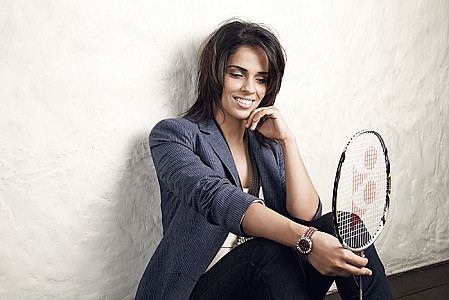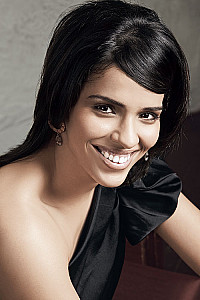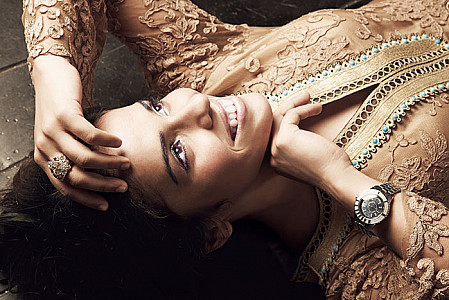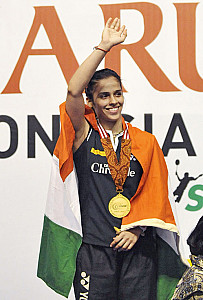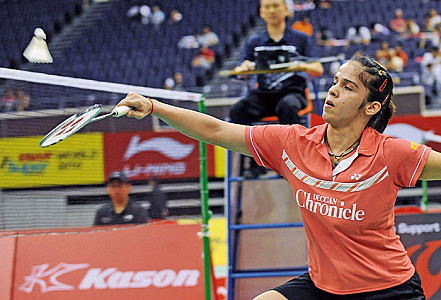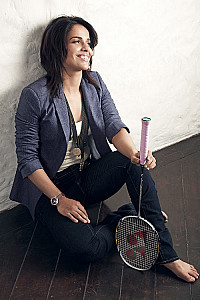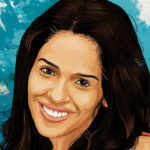Super Saina
Undoubtedly, she is one racqueteer whom India can be justifiably proud of. In the last few weeks, she has – soon after bagging the India Open Grand Prix 2010, the Singapore Open Super Series and the Indonesia Open Super Series titles in three successive wins in June – catapulted to the World No 3 position. Reaching a new high, the ace shuttler caught the collective imagination of not just her hometown, Hyderabad, but of the country as well. And in July, with 64791.2637 ranking points, she galloped one rank upwards, second only to World No 1 Yihan Wang.
Saina Nehwal marks an exclusive day with Verve in her calendar, which has us winging out from Mumbai to the City of Pearls. Leaving Hyderabad’s swanky airport behind us, we zip swiftly across the longest flyover in the country to reach the Taj Krishna, where we’ve asked the just-out-of-her-teens sensation to meet us.
At the appointed hour, I wait for her amidst the footfalls in the lobby, as the rest of the team readies itself in the Qutub Shahi suite on the seventh floor. “I am a few minutes away,” Saina messages and soon, I spot her stop by the security for the mandatory check that is purely perfunctory for her. The sports star picks up her purse and walks in unattended as faces turn to take a second look at her. Gone is the ‘Who is that girl?’ phase – she has moved out of the sidelines to take her rightful place in the spotlight.
The round of introductions dispensed with, she flops down on the chair facing the window to chat as make-up artiste Priya gets to work. Acknowledging our congratulations, Saina says, “The wins have given me a lot of confidence. It feels very good and is a different high.” It is her unblinking focus on winning that has kept 20-year-old Saina going ever since she picked up the racquet at the young age of eight to shuttle across courts, big and small, in the country and abroad. “More than playing badminton,” she laughs, “I love winning and seeing my photos in the papers. That drove me to play more and more. Even today, I love standing on the podium. Nothing else matters.”
The sunlight streaming in through the window highlights the light brown streaks in her short hair obtained during her recent winning spree at the tourneys. She admits that before big games, she cannot sleep at night…and also stays up holding her medals when she has won. Looking back, she says, “No one is happy when you lose a match. I feel like I could just cry when I lose; when I was younger, I would burst into tears. But, I have become stronger and learnt many lessons. Now, winning three titles without any mistakes is a big thing for me: because even if I played badly on one or two days, I did not lose heart. This has done a great deal for my confidence.”
As Nirali, our stylist, beckons her into the room to show her an array of outfits laid out for the shoot, she takes the relatively new experience in her stride – trying on one after the other so that she can sport what suits her best. Interestingly, she hardly turns around to catch a glimpse of her quicksilver changes, smiling even as she navigates her way through an unfamiliar top. Her sunshine temperament is what holds her in good stead in her game too. “Even if I lose my temper and shout sometimes, I will never hurl my racquet or break it. I play with it and have given my life to it. I do not have an attitude that makes me do all that. I have seen Sachin Tendulkar and Roger Federer playing; they are all so cool. I don’t get angry. If I lose my temper at home, perhaps when Mom cooks food I do not like, they laugh at me. They say I don’t know how to get angry. I am normally quiet and I listen to everyone,” Saina remarks.
Planning seems to have been her middle name from the day she picked up the racquet, having watched her parents playing the sport. Her foray into the world of badminton was inspired by her father, Dr Harvir Singh, a scientist at the Directorate of Oilseeds Research, Hyderabad and her mother, Usha Nehwal, both of whom have been former state badminton champions of Haryana. In December 1998, Saina’s father took her to meet Coach Nani Prasad at the Lal Bahadur Stadium, Hyderabad. The coach saw a spark in her and encouraged her to enrol as a summer trainee. And Indian badminton history began to be re-written.
From Hisar, where she was born, to Hyderabad, the city she has called home since her early childhood – the journey has yielded results. “I have to be disciplined. It is like an early job for me. People go to work even if they don’t like it. Initially, my father’s dream was that I become a doctor. At that time, neither I nor my parents knew that I would end up playing badminton professionally. I used to see my parents playing it, I often held the racquet. When I started, my first stroke was a smash. I was very aggressive. I used to swim, I played cricket with the boys, I did karate for a year but it became difficult – they jump on your stomach! When I started winning at badminton, and at 14 beat the national players, my parents let me continue with the game.”
Saina’s story of struggle has been well-chronicled – the road to her titles has not been an easy one. She remembers, “I would get up at 4 am and catch a bus at 4.30 am for the stadium 25 km away. I would skip the last two periods of school and practise till seven or eight. I often slept in the bus or even on the scooter. I have lost several racquets in autos. My father would buy stuff for me, and would get angry with me for doing that. My mother did not object to the long hours but she urged that we move closer to the stadium so that my father and I would not have to travel so much on busy roads on a scooter every day.”
For the uninitiated in badminton lore, her father reportedly dipped into his provident fund savings to fuel her dreams. But as Lady Fame began to dog her footsteps, her life became a little easier. Sponsors – first Yonex and now Deccan Chronicle (she is also the brand ambassador for Deccan Chargers) – stepped in to help the rising star. She acknowledges with gratitude, “Today, things are much easier as Deccan Chronicle takes care of many things for me. They make things comfortable for me in many ways. Being the brand ambassador for Deccan Chargers is a big thing, especially when the others with IPL teams are big film stars.”
Unlike other teens and growing girls who chill out at coffee shops, stalk sales at malls or continually romance their cells, Saina does none of these…. Ask her if all play did not make her a dull Jill and she ripostes, “I do whatever I am told to do. So, people believe that Saina will always listen. Basically, I am a nice person. I love the game so much that I want to spend time on the court. Even while growing up I would love working hard. My body would hurt after work outs, but I loved the pain. I do not think that I have missed something in my life. I want to make myself so perfect that I will become World No 1. That is my target.”
Walking tall in her chosen field, she looks askance at the high-heeled shoes in front of her and chooses to wear her flats till the camera is trained on her. “I never wear heels,” she points out. “I am normally in keds or slippers. They are much more comfortable and good for the back.” At the end of it all, it’s all a matter of the game for her. She’s even changed her food habits to up her power quotient. “You must have a good physique in this game,” she says. “I have a strong body. I cannot put on weight. So, I stopped eating oily food and ice creams. I turned non-vegetarian a few years ago because abroad, you do not find good vegetarian food. So, now I eat chicken, roti, dal and rice and avoid chocolate. Only when I win do I treat myself and eat whatever I want.”
By now, Saina is dressed in the Gayatri Khanna ensemble and we are ready to roll. As our small entourage strolls down to where our photographer, Vishesh, awaits us with our creative director, Falguni, we try to shield her from inquiring eyes, clad as she is in a short skirt and an off-the-shoulder top. Unselfconsciously she says, “Don’t worry. I am used to having eyes on me. When you are playing on court, wearing sports’ skirts, everyone is watching you.”
And yet, even in a crowd, she is alone. “It is tough to make time for friends,” she states. “I am not in touch with anyone. Now that you mention it, yes, I am lonely. As players, we do miss friends but we don’t realise it at that time. When I stop playing, I may feel their absence. But I am used to playing alone; sometimes without coaches or companions.
Badminton is a sport where you will be alone throughout your career because not many people from India reach the semis or finals. Whoever is at the top or is doing well is alone. No one wants to be their friend. Other players look at you and feel, ‘she is doing well and I am not’; hardly anyone speaks to you except for your coach or parents. Jealousy exists, more so between girls.”
It’s time for a change and, sipping on a glass of guava juice, Saina admits, “All this is exciting. But I feel scared because it should not hamper my game. I am getting to do all this because I have done so well. I don’t want my performance to drop. Badminton needs this attention. I will have to do everything I can to help my game become more popular. This summer, we had almost 150 kids at the academy for the camp, because of my success. It was unbelievable.”
Her “I-am-proud-to-be-an-Indian” attitude is reflected in the three clips she often wears in her hair at matches. “I love the colours that make up our flag,” says India’s top shuttler. “Everyone dies to do something for the country. I am the lucky one who gets to do it. I’m proud to be making a name for my country in the world of badminton.”
When successful sports stars morph swiftly into icons on a pedestal, it is easy to forget that Saina is still almost a child at heart. She has a passion for phones and cars, even though she does not continuously bond with her phone. “The last film I saw was Raajneeti but Shah Rukh is my favourite star,” she says. “He has come from nowhere, worked hard and achieved everything on his own steam. That is truly inspiring. I watch a few movies, watch TV and don’t really go out to restaurants or picnics. Now it’s tough to go to a theatre; people won’t let me watch the movie. They just want to come up and talk. When I am at home during the day, I sleep or rest. During the day, I am busy at the Gopichand Badminton Academy for my games. It is the only life I know and I will not trade places with anyone else in the world.”
Academics took a back seat and she stopped post her 12th standard. “After I played the Olympics, I thought that I should give a 100 per cent to my sport. It had become difficult to juggle school work and my game,” she states. “I can always return to it later; I would not have been able to perfect my game at 30.” Everything else blends seamlessly into the melting pot called badminton. Though she has travelled to global spots for tournaments a real holiday is a distant dream. “Holiday?” she asks. “My parents are still waiting for that. If I get a chance I will surely go to Singapore, it’s a lovely place to have fun. I haven’t had the chance for years to go anywhere, except to play. I have been to Malaysia but I never saw the Twin Towers.”
Her mentors and best friends are still her parents and ‘Gopi Sir’ – Pullela Gopichand, the iconic badminton player who is her coach and guide. “I tell my mother everything and try to share as much as possible with her,” says Saina. “It relaxes me after a tough day at sport. My father is very emotional. When he comes to tournaments with me, he gets nervous and so he watches me on television. Gopi Sir is very down to earth and keeps me that way.”
She is completely uninhibited in front of the camera and her smile – one seen as she pumps her hand in victory on the court – is a delight to capture. Squatting on the floor, she twirls the racquet on the surface. “I used to get nervous when I lost points,” she remembers. “I am trying to be cool and calm, strengthening my self-belief. Often opponents use distracting techniques, especially when you are serving. You have to be strong and patient. Anything can rattle you. Once, I got stuck in the hotel lift for 15 to 20 minutes in Indonesia. Luckily, the stadium was just five minutes away. I rushed to the stadium just half an hour before the match and thought I had lost it. But I played excellently and won.”
One loss that the first Indian woman to reach the singles quarter-finals at the Beijing 2008 Olympics will never forget is that defeat. “I do not normally break down on court. I know I have chances of coming back into the game till I am match point down. I loved the stadium so much that I did not want to leave it. I was so sad after that loss. Olympics do not happen every year. But I am now looking forward to winning the gold in London,” she says. There are three important tournaments on the anvil this year – the World Championships, the Commonwealth Games and the Asian Games. “Winning three tournaments is not easy. People imagine that I will stroll into the No 1 position. I will be happy if I win tournaments. The ranking will automatically come,” Saina states confidently.
As Comet Saina begins to sweep across the galaxy of the public imagination brighter than ever before, the inevitable question arises: will she fall prey to the lure of glamour and brands that are bound to trail her success, forfeiting the quality of her game in the process? Peering up at the lens as the photographer prepares to take a top shot, she says, “There is always a big tournament ahead of you and you have to keep your focus clear. When you become a big personality in India, people want you everywhere. But, I don’t think I will change. Did Sachin change himself? He is the same guy. I am okay with whatever I am getting. I am sure with my achievements and performances I will get a lot more. But I don’t need to go to parties. I am a sportsperson playing for the country. And that is all that matters.”
Mixing with the best
Dileep Premachandran, Asia correspondent for The Guardian, on India’s ace shuttler
Three titles in a month, two of them in A-list events. For a nation so starved of sporting success that it has a distended belly, Saina Nehwal’s recent achievements could cause indigestion. Forget the cricketers and the No 1 ranking in a sport that less than half a dozen nations take seriously. Think instead of a girl who used to do 50 km round-trips from the age of eight – waking up at 4 am – so that she could excel in a country where sport is watched rather than played.
Like Prakash Padukone, whose own purple patch 30 years ago took in the Danish and Swedish Opens and the All England title, Saina was lucky to be born into a family with a sporting tradition. When she became the first Indian woman to win a tournament of note in the Phillippines in 2006, she was only 16. Aparna Popat had dominated badminton in India for nearly a decade, but found glory far harder to come by once she crossed passport control.
Saina is currently the only non-Chinese player in the top five, and has shown signs of being able to mix it with the very best. In the semi-finals in Singapore, she was hammered in the first game by Lu Lan, world champion last year, before coming back to win in convincing fashion.
Off the court, she’s both personable and marketable, though she hasn’t captured the imagination quite like her near-namesake, Sania Mirza, did during her brief flirtation with the higher echelons of women’s tennis. It’s perhaps Saina’s good fortune that she plays a less high-profile sport, one where she’s less likely to be tripped by fame and fortune.
Over a quarter century has passed since PT Usha crossed the finish line one-hundredth of a second behind Cristeana Cojocaru at the Memorial Coliseum in Los Angeles. That remains the benchmark for Indian women that take to sport. At least now, there appears to be someone ready to grasp the standard and head off into unknown and exciting territory.
Recent feathers in her cap
Indonesia Open Super Series (2009)
India Open Grand Prix (2009)
India Open Grand Prix (2010)
Singapore Open Super Series (2010)
Indonesia Open Super Series (2010)
Related posts from Verve:
Verve Trending
Sorry. No data so far.
us on Facebook to stay updated with the latest trends

